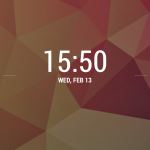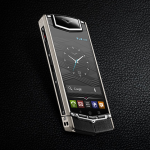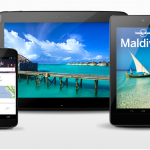Sony Xperia Z receives root and joins the modding ranks

With Sony's efforts to support the Android modding and developer community, it really should come as no surprise that the recently-unveiled Xperia Z smartphone is now bestowed with root. The noteworthy achievement is facilitated by the CF-Auto-Root solution available for the LG-made Google Nexus 4, a device which shares most of the underpinnings of the Xperia Z.
The two devices share the same 1.5GHz quad-core Qualcomm Snapdragon S4 Pro chipset and because of it the developer has only slightly modified the Nexus 4 ramdisk from CF-Auto-Root to unleash elevated privileges on the Xperia Z. The app chosen to manage rooting requests is the traditional SuperSU.
Samsung announces the Wi-Fi Galaxy Camera

On Tuesday, Samsung unveiled a new Galaxy Camera model featuring Wi-Fi-only connectivity. The South Korean manufacturer spares no expense, pairing the device with a quad-core processor and the first Jelly Bean iteration, among other noteworthy features.
With the Wi-Fi-only Galaxy Camera. Samsung drops support for 3G/4G LTE connectivity but maintains most of the specs from the original version. The new model features a 4.8-inch HD display with a resolution of 1280 by 720 and 308ppi density. The camera is powered by a 1.4GHz quad-core processor and a 1,650mAh battery, with the display and processor combination similar to the one found in the company's flagship Android smartphone, the Galaxy S III.
Firefox 19 debuts a built-in PDF viewer and other improvements

Mozilla has released Firefox 19.0 FINAL for desktop. There are only two notable new features in this new build, but after months stuck in beta, Mozilla has finally enabled its built-in PDF viewer, which allows users to view PDFs directly in the web browser without having to use a third-party viewing utility.
The other major new feature is a security one, with the Firefox Awesomebar now set up to alert users if the default search provider has been changed. In the meantime, Firefox 19.0 for Android -- due for release imminently -- will introduce support for themes, plus lower its system requirements to extend its reach to as many as 15 million more smartphones.
Vic Gundotra hints at better camera for future Nexus smartphones

Google Nexus smartphones are known for a few good things -- they tout the latest unadulterated version of Android, the hardware inside is decently fast, the build quality is surprisingly good, and the price doesn't burn a hole in the pocket. But if there's one area where no Nexus smartphone shines, it's definitely in the camera department.
As a Galaxy Nexus owner I have often faced a camera dilemma -- do I shoot bad pics just to have them, or stick with taking a mental snapshot. More often than not the latter seems to be the way to go. It's not that the cameras are overly bad, it's just that in order to take a remotely-decent picture I'd have to fiddle around with the software and by the time I found the good setup the perfect moment will have already passed. And don't get me started on noise or clarity. But it appears that will soon change as Google is finally making the camera a priority.
LG finally details the 'second and different' Optimus G Pro

Unveiling a smartphone without specs is like announcing a movie without releasing a trailer and only showing the poster to get everyone excited. That's exactly what LG did, little less than a week ago, with the 'second and different' Optimus G Pro. It got us confused, and worked up, and took the South Korean manufacturer until Monday to finally give in and spill the beans.
Last week LG revealed very little about the Optimus G Pro, only focusing on two major areas -- the display and the processor. The former is known to feature a "2.5D" effect, similar to the faux-3D virtual geometric model used in games, for instance. The panel is a 5.5-inch unit backed by a resolution of 1920 by 1080. LG gave even less away when it came to the processor, only mentioning that it is of quad-core origin. But let's stop looking at the poster and watch the trailer instead.
Archos unveils the Platinum tablet lineup

On Valentine's day, French consumer electronics company Archos professed its love for mobile technology by unveiling a new tablet lineup dubbed Platinum. The three devices, 80 Platinum, 97 Platinum HD and 116 Platinum, are designed for the wallet-conscious tablet buyers while also sporting pretty decent hardware specifications.
The common denominators between the three tablets are found inside the shell, with only the physical dimensions and screen specifications separating them. The devices share a quad-core 1.2GHz processor backed by an 8-core GPU (Graphics Processing Unit) and 2GB of RAM. Archos also throws in its branded Media Center applications, front and back cameras, as well as a mini-HDMI port and microSD card slot.
Google posts Android 4.2.2 factory images for Nexus 4, 7, 10 and HSPA+ Galaxy smartphone

Three days ago, Google released the much-anticipated Android 4.2.2 Jelly Bean update, containing security improvements as well as Bluetooth-related bug fixes. Making Nexus owners even happier (well, at least some of them), the search giant also updated the factory images with the latest green droid iteration.
Among other purposes, the factory images can be used to restore Nexus-branded devices to a stock state after previously running custom green droid distributions, or update them to the latest version of Android. At a quick glance, for my Galaxy Nexus smartphone, the Android 4.2.2 Jelly Bean factory images ship with a newer radio (XXLJ1), as well as a more recently-dated kernel (version 3.0.31, with a November 28 time-stamp). The "userdata.img" file is also freshly-dated with a February 8 build date.
Get your phones ready -- The Brit Awards to be Shazam-enabled

British broadcaster ITV has agreed to a deal with Shazam -- the popular music identification service -- allowing viewers of this year’s The Brits music awards to access exclusive content during the live broadcast -- a UK first.
By using Shazam to tag the show between 8pm and 10:15pm on February 20, viewers will get access to exclusive behind-the-scenes content from performers and guest presenters.
There is little room for a third smartphone platform

"We're No. 3!" will be BlackBerry's and Microsoft's rallying cry this year. Android and iOS so dominate the smartphone market, the best -- and quite honestly dismal -- hope is third; distant at that. Combined, based on actual phone sales, Android and iOS had 90.1 percent share during fourth quarter, up from 74.9 percent a year earlier, according to Gartner. BlackBerry and Windows Phone are neck-and-neck, with lowly 3.5 percent and 3 percent standings, respectively.
Upstarts want third place, too. Anshul Gupta, Gartner principal research analyst, explains: "2013 will be the year of the rise of the third ecosystem as the battle between the new BlackBerry10 and Widows Phone intensifies. As carriers and vendors feel the pressure of the strong Android’s growth, alternative operating systems such as Tizen, Firefox, Ubuntu and Jolla will try and carve out an opportunity by positioning themselves as profitable alternatives".
Use DashClock widget to empower the Android 4.2 Jelly Bean lockscreen

One of the least impressive features added by Google in Android 4.2 is the ability to use lockscreen widgets. By default the second Jelly Bean iteration comes with a limited number of options, none of which is capable of delivering enough glanceable information without swiping left and right to find emails or calendar entries. With DashClock Widget the true potential of lockscreen widgets is unleashed by displaying relevant "status items" right after unlocking the device, all in one go.
DashClock Widget can be used as a Digital clock widget replacement, further building on the stock functionality by introducing support for next scheduled alarm, upcoming calendar appointments, missed calls and unread texts, unread Gmail inbox or Priority inbox count as well as local weather data. Straight off the bat it puts the stock lockscreen widgets to shame by combining sufficient relevant information, all in one place.
Vertu launches its first Android smartphone. Anyone got a spare $21,700?

Luxury British smartphone manufacturer Vertu used to be owned by Nokia and made its name producing incredibly expensive Symbian handsets. But times move on, and the company is now focusing on producing incredibly expensive Android handsets.
The first new product of this endeavor is the Vertu Ti. The 3.7-inch device sports a brushed titanium frame (making it up to five times stronger, and at 180g (6oz) quite a bit heavier than most other phones), with real leather trim and a sapphire-screen.
AOKP Jelly Bean MR1 Build 3 is available

Little more than three weeks since the last build, Android Open Kang Project, the team behind the popular AOKP green droid custom distribution, has unveiled Jelly Bean MR1 Build 3. The newest stable build sports the latest bug fixes and improvements added before Google released Android 4.2.2.
The team behind the project warns that issues related to Bluetooth should not be reported, as "it can’t/won’t be fixed before the 4.2.2 merge". The timing is rather interesting seeing as Google reportedly took charge and finally improved Bluetooth connections in the latest update, which arrives less than a day after the release of Jelly Bean MR1 Build 3. The new build introduces support for a couple of new devices, including the Acer Iconia Tab A510 (codename "a510"), the T-Mobile variant of the Samsung Galaxy S II (codename "hercules") and the LTE variant of the Samsung Galaxy Note II (codename "t0lte").
Android 4.2.2 rolling out for Nexus devices

Google Nexus owners, unlock your devices and start checking for updates because Android 4.2.2 Jelly Bean is now rolling out. The latest software version is reportedly hitting Galaxy Nexus, Nexus 7 and Nexus 10 devices, with no word at the moment relating to the Nexus 4.
The Android 4.2.2 update bumps up the build number to version JDQ39 and mostly appears to contain minor fixes. No official changelog has been provided by Google at this moment, but users are reporting improvements for Bluetooth streaming which now presents "less hicups [...] but still not perfect" with apparent disconnects when switching from Wi-Fi to cellular data.
Sony details the Android 4.1 Jelly Bean upgrade for Xperia smartphones

Sony's Android 4.1 Jelly Bean upgrade for 2012 Xperia smartphones is a long time coming. The Japanese manufacturer announced its plans in mid-October last year, and followed it up with a brief update two months later. Finally, as planned, deployment is set to kick off "this week".
The first smartphones to receive the coveted upgrade to the original Jelly Bean iteration are the Xperia T and Xperia, with Xperia TX owners having to wait until next month for the same software treatment. In an attempt to appease impatient users and to drum up some interest, Sony has decided to spill the beans on what Android 4.1 Jelly Bean entails for Xperia users by providing a list of significant changes included in the upgrade.
iPhone cracks against the Great Wall of China

The Chinese smartphone market is dominated by five top manufacturers, none of them Apple, Canalys reveals. As I've warned a couple times recently, despite CEO Tim Cook's prognostications about China's importance or his company boasting 2 million first-weekend iPhone 5 sales, competitors rapidly close out the market for costly fruit-logos.
China is the biggest market for mobiles, largely dominated by smartphones -- 73 percent of the total in fourth quarter, up from 40 percent a year earlier. Shipments soared 113 percent to 64.7 million units, or 30 percent of all smartphones globally. Samsung captured the top spot, followed by Lenovo, Yulong, Huawei and ZTE.
Recent Headlines
Most Commented Stories
© 1998-2025 BetaNews, Inc. All Rights Reserved. Privacy Policy - Cookie Policy.